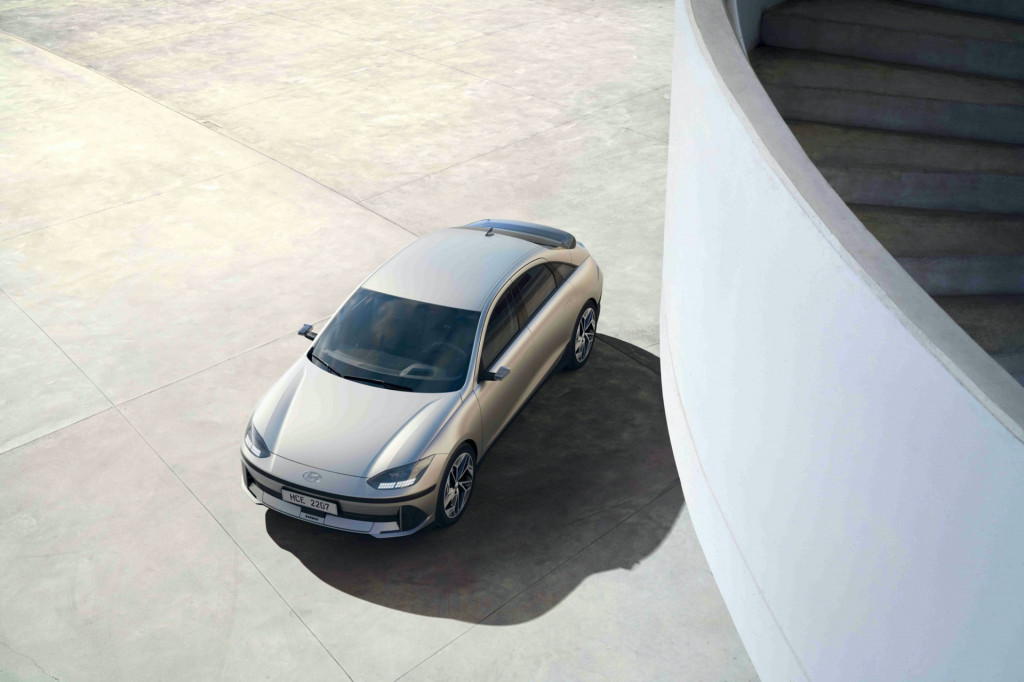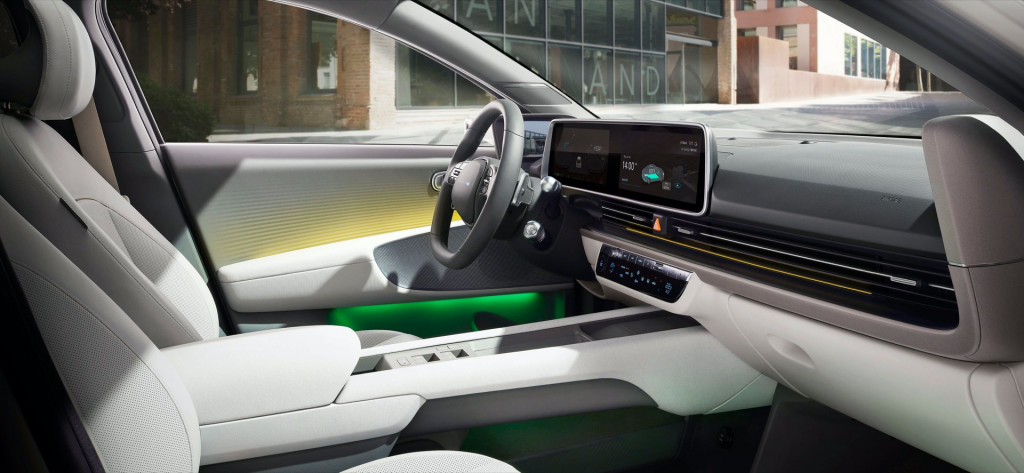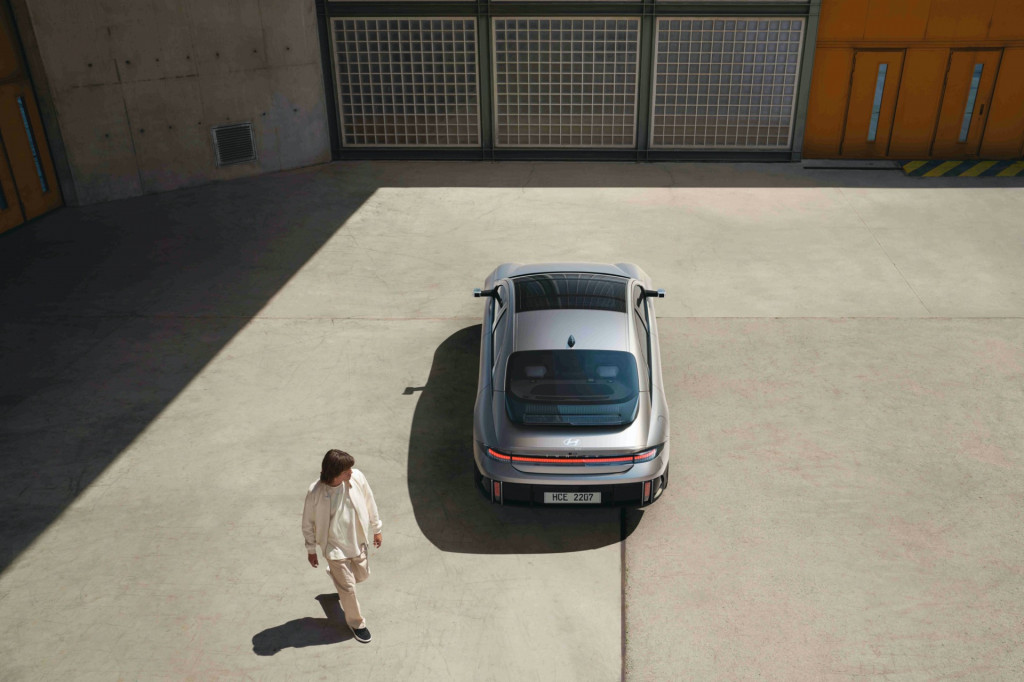The Hyundai Ioniq 6 electric sedan, just confirmed to be U.S.-bound in early 2023, looks very different than the Ioniq 5, while sharing a lot with the equally head-turning crossover underneath.
Despite that, it gains a series of engineering improvements that didn’t quite make the cut for the earlier-release crossover—and it could, for the time being, give the electric sedan an advantage to those who want the leading-edge tech.
Both Ioniq 5 and Ioniq 6 were developed together on the E-GMP platform, with the same flat-floor battery and structural basics, plus identical battery specs and chemistry, both ready for bi-directional charging and equipped for vehicle-to-load (V2L) utility permitting you to power appliances or campsites. But the Ioniq 6 achieves a WLTP range of 379 miles (610 km), with a consumption of more than 4.4 miles per kwh on that cycle. To compare, the Ioniq 5 is rated at 315 miles (507 km) WLTP with the same pack.
Hyundai Ioniq 6
That latter version achieves an EPA-rated 303 miles. So we might potentially see an EPA rating for the Ioniq 6 of more than 350 miles.
Optimizing software and hardware, efficiency in mind
How was Hyundai able to secure so much additional driving range from the Ioniq 6 given the same pack? In a recent session with the press about the Ioniq 6, YongWha Kim, the executive vice president for the company’s Vehicle Control Development Center, said that Hyundai engineers have worked to discover the most optimal points for acceleration and braking efficiency. He also pointed to “very convenient conditioning technology” for the battery pack.
It turns out that was just the start. Several innovative technologies to improve both energy efficiency and range, Kim explained, both in hardware and in software. A different power module with next-generation semiconductor technology plays a role, improving energy conversion efficiency. Also the motors employ hairpin winding technology to improve efficiency.

Hyundai Ioniq 6
“Last but not least, we worked on controls, and the transition between two-wheel drive and all-wheel drive, fine-tuned to further improve vehicle energy efficiency,” said Kim, who also credited the “fabulous aerodynamic design,” with a coefficient of drag of just 0.21.
Hyundai hasn’t disclosed a weight difference yet, but we assume that has a role, too.
A little more future-proof
The Ioniq 6 has another key piece of technology that gives it an advantage over many EVs, and the Ioniq 5, Kim confirmed: It will be the first model from Hyundai to offer over-the-air updates, and future autonomous driving capability.

Hyundai Ioniq 6
“Many vehicle controllers can be updated, and we will keep improving the experience with OTA features,” he said.
Although Kim didn’t connect the dots, that likely means that there’s potential to, as Tesla has done at times, improve the efficiency and driving range, or improve charging characteristics.

where to buy lasuna without a prescription – buy himcolin pill cheap himcolin generic
gabapentin tablets – brand neurontin 800mg buy sulfasalazine 500 mg pill
besivance cheap – cheap generic sildamax cost sildamax
order celebrex 200mg generic – urispas canada purchase indomethacin generic
buy generic benemid 500 mg – buy tegretol 200mg generic carbamazepine buy online
order diclofenac online – buy voltaren 100mg sale order aspirin 75mg online
order mebeverine – buy generic pletal over the counter order generic cilostazol
pyridostigmine 60 mg ca – buy mestinon 60 mg order imuran 50mg online cheap
oral rumalaya – buy rumalaya for sale brand endep 10mg
buy diclofenac generic – buy isosorbide 40mg without prescription purchase nimotop sale
order cyproheptadine without prescription – periactin uk buy zanaflex tablets
order meloxicam 15mg sale – generic maxalt 5mg buy toradol 10mg pills
buy generic cefdinir online – order omnicef 300mg pills cost cleocin
buy trihexyphenidyl for sale – diclofenac gel purchase online order emulgel online
order accutane 10mg without prescription – isotretinoin tablet deltasone over the counter
buy generic betamethasone – order monobenzone generic how to get monobenzone without a prescription
buy permethrin cheap – buy permethrin generic retin cream drug
buy flagyl sale – cenforce 100mg usa cenforce 50mg tablet
augmentin 1000mg ca – purchase synthroid pill oral synthroid 100mcg
buy losartan without prescription – cheap cephalexin 125mg purchase cephalexin generic
cleocin buy online – buy cleocin pills for sale indomethacin 75mg drug
provigil 100mg without prescription – buy promethazine 25mg pill meloset online order
crotamiton online – mupirocin online buy aczone pills
zyban sale – order zyban 150mg purchase shuddha guggulu pill
capecitabine 500mg for sale – buy naproxen generic danazol tablet
brand prometrium 200mg – oral ponstel cheap clomiphene without prescription
fosamax 35mg us – pilex online order order generic medroxyprogesterone 10mg
order dostinex 0.25mg without prescription – cabgolin cheap alesse tablet
жЈи¦Џе“Ѓгѓ—гѓ¬гѓ‰гѓ‹гѓійЊ гЃ®жЈгЃ—い処方 – гѓ—гѓ¬гѓ‰гѓ‹гѓі еЂ¤ж®µ г‚ёг‚№гѓгѓћгѓѓг‚Ї гЃ®иіје…Ґ